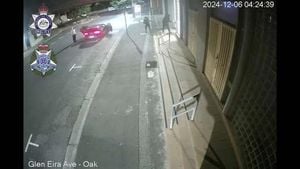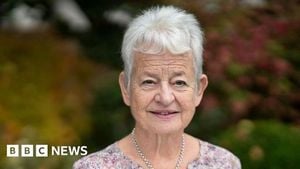On August 21, 2025, the High Court in Glasgow handed down a 10-year custodial sentence to a 17-year-old from Inverclyde, Scotland, for plotting a terrorist attack on the Inverclyde Muslim Centre in Greenock. The teenager, whose identity is protected due to his age, had meticulously planned to set the mosque ablaze during peak worship hours, aiming for maximum casualties. The case has sent shockwaves through the local community and raised urgent questions about radicalization, online extremism, and the safety of minority communities in the UK.
According to Sky News, the teenager was arrested in January 2025 as he attempted to enter the mosque, carrying a rucksack filled with a German-manufactured air pistol, ball bearings, gas cartridges, and several cans of aerosol spray—tools he intended to use to start the fire and trap worshippers inside. The mosque, which can accommodate up to 275 people, was expected to be full at the time of the planned attack. Police had received intelligence about the plot and were waiting to apprehend him at the door, effectively stopping the attack at the last possible moment.
During sentencing, Judge Lord Arthurson did not mince words, describing the planned act as “a quite diabolical atrocity involving extreme violence and multiple deaths.” He added, “You even requested that your attack be live-streamed. Your conduct was only stopped by your arrest when you were, quite literally, at the very door of the centre.” The judge ordered an additional eight years of supervision after the teenager’s release, underscoring the severity of the crime and the ongoing risk to the public.
The details of the plot are chilling. As reported by BBC Scotland News, the teenager had managed to befriend the mosque’s imam by pretending to be interested in converting to Islam. Trusted by the community, he was allowed to move freely within the mosque, filming and sketching the layout, and even joining the mosque’s WhatsApp group, ostensibly seeking guidance. Hamid Akhtar, chairman of the mosque, expressed his shock and sadness at the betrayal: “The frightening bit was that somebody was so nice. Making us a fool that he wanted to convert, and we were helping him in every way and trusting him. It gives us a lesson in future about who comes in and what their intentions are. We have more security cameras now.”
The teenager’s radicalization began early. Prosecutors told the court that he had been exposed to extremist content on social media from the age of 13. He idolized notorious figures such as Adolf Hitler, Benito Mussolini, and Norwegian mass murderer Anders Breivik. On his mobile phone, police found a manifesto filled with hateful rants against Muslims and Jews, as well as a list of fascist “inspirations.” The manifesto, described by the judge as “a declaration of intent,” included statements like, “I am hateful and want to kill, that is my sole motive in life and it’s what I intend doing even if it costs me my life,” and “Tomorrow I will burn that f****** mosque to the ground.”
Initially, the teenager had contemplated carrying out a terrorist attack at his own school in Inverclyde. He recorded himself walking through the building, discussing plans to “liquidate” an office. However, he eventually shifted his focus to the mosque, believing he could inflict more harm there. He boasted on Telegram about infiltrating the mosque and discussed plans to livestream the attack, hoping to inspire others. On the morning of the planned massacre, he messaged friends, “Today, I choose what my life was and will be.”
Police Scotland’s swift response was widely praised. Assistant Chief Constable Stuart Houston commended the officers involved, stating, “I want to pay tribute to the officers who took swift action to protect the public and apprehended the youth, as the potential consequences of his actions could have been extremely serious and had a profound effect on the community. This was a fast-moving and complicated inquiry and officers carried out a diligent and thorough investigation to gather the evidence and brought him to court, which will now see him face the consequences of his intentions.”
The investigation uncovered a disturbing cache at the teenager’s home: a copy of Hitler’s Mein Kampf, air weapons, knives, masks, and ingredients for making explosives. Notepads adorned with swastikas and detailed sketches of the mosque’s layout further illustrated the depth of his neo-Nazi beliefs. Sineidin Corrins, deputy procurator fiscal for specialist casework at the Crown Office and Procurator Fiscal Service, described the offences as “deeply disturbing.” She explained, “Viewing, sharing and posting such extreme and illegal material online can encourage and incite others into extremist activity, spreads hatred and poses a serious risk of harm to the public. This heinous plan to attack those within his own local community was prepared and driven by racial and religiously motivated hatred and showed that he not only held neo-Nazi beliefs but was about to act on them to cause pain and suffering. Fortunately, he was apprehended and this was prevented.”
The local Muslim community has responded with a mix of relief, forgiveness, and renewed caution. Mohammed Akhtar, the mosque’s chairman, told BBC Scotland News, “We hope the young person can get the support and help he needs to understand the impact of his action. And we have sympathy for his family for such a difficult time. Forgiveness and understanding each other. That’s the most important thing. If you understand each other, most of the problems can be solved.” The mosque has since increased its security measures, installing more cameras and reviewing its policies for welcoming new members.
Omar Afzal, from the Scottish Association of Mosques, emphasized the wider implications: “This was a calculated and horrific plan to attack innocent worshippers. Thankfully, swift action from Police Scotland thwarted a tragedy targeting hundreds but has left the community deeply shaken. Communities cannot live in fear. The best response to hate is solidarity. But solidarity must be matched by policy, education, and political leadership.”
This case has highlighted the persistent threat posed by online radicalization and the need for vigilance among both law enforcement and communities. It also raises important questions about how society can support vulnerable young people—especially those with mental health diagnoses—before they are drawn into extremism. The teenager in this case had an autism diagnosis and, according to the court, believed in a “war” between white people and other races. His journey from online radicalization to the brink of mass murder serves as a sobering warning of the dangers lurking in digital spaces and the importance of early intervention.
As the community in Greenock moves forward, the scars of this near-tragedy remain. But so too does a sense of resilience and a renewed commitment to dialogue, understanding, and vigilance. The swift prevention of this attack stands as a testament to the importance of intelligence-led policing and the power of community solidarity in the face of hate.






